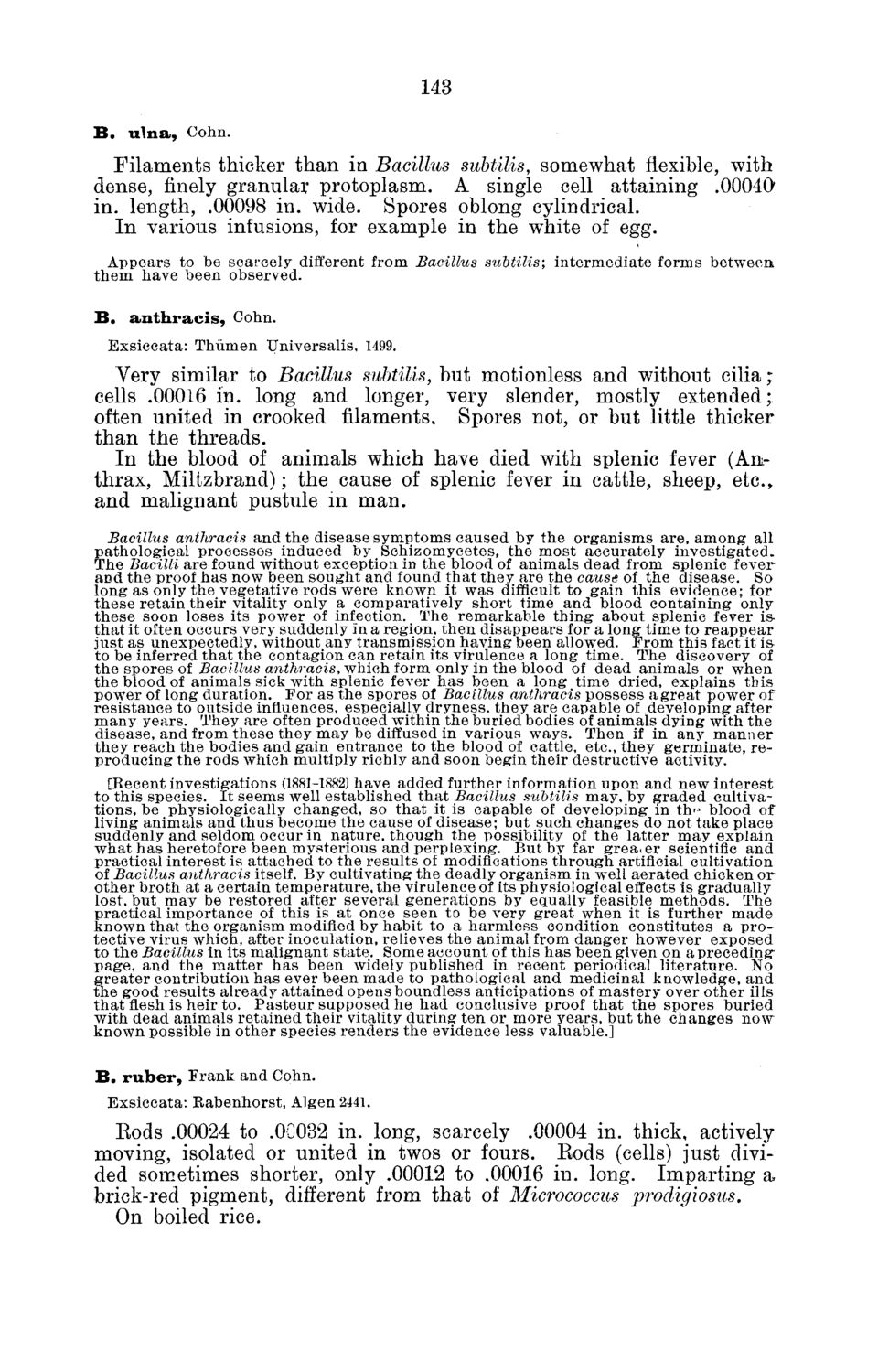| |
| |
Caption: Board of Trustees Minutes - 1882
This is a reduced-resolution page image for fast online browsing.

EXTRACTED TEXT FROM PAGE:
143 B . u l n a , Cohn. Filaments thicker than in Bacillus dense, finely granular protoplasm. in. length, .00098 in. wide. Spores In various infusions, for example subtilis, somewhat flexible, with A single cell attaining .00040 oblong cylindrical. in the white of egg. Appears to be scarcely different from Bacillus subtilis; intermediate forms between them have been observed. B . a n t h r a c i s , Cohn. Exsiccata: Thumen Universalis, 1499. Very similar to Bacillus subtilis, but motionless and without cilia; cells .00016 in. long and longer, very slender, mostly extended; often united in crooked filaments. Spores not, or but little thicker than the threads. In the blood of animals which have died with splenic fever (Anthrax, Miltzbrand); the cause of splenic fever in cattle, sheep, etc., and malignant pustule in man. Bacillus anthracis and the disease symptoms caused by the organisms are, among all pathological processes induced by Schizomycetes, the most accurately investigated. The Bacilli are found without exception in the blood of animals dead from splenic fever and the proof has now been sought and found that they are the cause of the disease. So long as only the vegetative rods were known it was difficult to gain this evidence; for these retain their vitality only a comparatively short time and blood containing only these soon loses its power of infection. The remarkable thing about splenic fever isthat it often occurs very suddenly in a region, then disappears for a long time to reappear just as unexpectedly, without any transmission having been allowed. From this fact it is to be inferred that the contagion can retain its virulence a long time. The discovery of the spores of Bacillus anthracis, which form only in the blood of dead animals or when the blood of animals sick with splenic fever has been a long time dried, explains this power of long duration. For as the spores of Bacillus anthracis possess a great power of resistance to outside influences, especially dryness, they are capable of developing after many years. They are often produced within the buried bodies of animals dying with the disease, and from these they may be diffused in various ways. Then if in any manner they reach the bodies and gain entrance to the blood of cattle, etc., they germinate, reproducing the rods which multiply richly and soon begin their destructive activity. [Recent investigations (1881-1882) have added further information upon and new interest to this species. It seems well established that Bacillus subtilis may, by graded cultivations, be physiologically changed, so that it is capable of developing in th<> blood of living animals and thus become the cause of disease; but such changes do not take place suddenly and seldom occur in nature, though the possibility of the latter may explain what has heretofore been mysterious and perplexing. But by far greater scientific and practical interest is attached to the results of modifications through artificial cultivation of Bacillus anthracis itself. By cultivating the deadly organism in well aerated chicken or other broth at a certain temperature, the virulence of its physiological effects is gradually lost, but may be restored after several generations by equally feasible methods. The practical importance of this is at once seen to be very great when it is further made known that the organism modified by habit to a harmless condition constitutes a protective virus which, after inoculation, relieves the animal from danger however exposed to the Bacillus in its malignant state. Some account of this has been given on a preceding page, and the matter has been widely published in recent periodical literature. No greater contribution has ever been made to pathological and medicinal knowledge, and the good results already attained opens boundless anticipations of mastery over other ills that flesh is heir to. Pasteur supposed he had conclusive proof that the spores buried with dead animals retained their vitality during ten or more years, but the changes now known possible in other species renders the evidence less valuable.] B . r u b e r , Frank and Cohn. Exsiccata: Rabenhorst, Algen 2441. Eods .00024 to .00032 in. long, scarcely .00004 in. thick, actively moving, isolated or united in twos or fours. Eods (cells) just divided sometimes shorter, only .00012 to .00016 in. long. Imparting a brick-red pigment, different from that of Micrococcus prodigiosus. On boiled rice.
| |